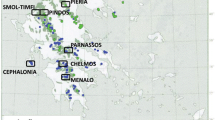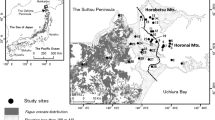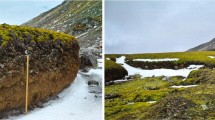Abstract
Genetic exchange between divergent lineages of silver fir (Abies alba Mill.) was studied in the Ukrainian Carpathians where two expanding populations originating from different glacial refugia meet. The study included 33 silver fir populations from Ukraine, Romania and Slovakia which were investigated using the maternally inherited mitochondrial nad5-4 marker and biparentally inherited nuclear microsatellites. The boundary between mitochondrial lineages is very sharp; only six populations containing a mixture of different haplotypes were found. Bayesian analysis of population structure based on seven nSSR loci revealed the existence of two clusters which coincided fairly well with mitochondrial lineages. Both haplotype frequencies and proportions of clusters identified by the Bayesian analysis exhibited a clinal transition over the contact zone, with cline widths of 17.6 km for mitochondrial haplotype frequencies (reflecting gene flow by seeds) and 119.6 km for Bayesian clusters based on nSSR (reflecting gene flow by pollen). Allelic richness and gene diversity differ significantly between mitochondrial lineages, the Balkan group being more variable, but an increase in gene diversity towards the boundary between lineages was observed only within the Balkan lineage. The observed patterns are suggested to reflect the postglacial colonization and historical gene flow. They demonstrated that in silver fir as a wind-dispersed species, the colonization front is quite continuous, and the survival of migrant seeds in already established populations is low. The relative contribution of pollen-mediated gene flow to genetic exchange between divergent lineages associated with glacial refugia is much higher than in the case of seeds, but pollen dispersal distance is lower than suggested by earlier studies.




Similar content being viewed by others
References
Arend M, Kuster T, Gunthardt-Goerg MS, Dobbertin M (2011) Provenance-specific growth responses to drought and air warming in three European oak species (Quercus robur, Q. petraea and Q. pubescens). Tree Physiol 31:287–297
Augspurger CK, Kitajima K (1992) Experimental studies of seedling recruitment from contrasting seed distributions. Ecology 73:1270–1284
Barton NH, Hewitt GM (1985) Analysis of hybrid zones. Annu Rev Ecol Syst 16:113–148
Birchler JA, Yao H, Chudalayandi S (2006) Unraveling the genetic basis of hybrid vigor. Proc Natl Acad Sci USA 103:12957–12958
Burke JM, Arnold ML (2001) Genetics and the fitness of hybrids. Annu Rev Genet 35:31–52
Comps B, Gömöry D, Letouzey J, Thiébaut B, Petit RJ (2001) Diverging trends between heterozygosity and allelic richness during postglacial colonization in the European beech. Genetics 157:389–397
Cremer E, Liepelt S, Sebastiani F, Buonamici A, Michalczyk IM, Ziegenhagen B, Vendramin GG (2006) Identification and characterization of nuclear microsatellite loci in Abies alba Mill. Mol Ecol Notes 6:374–376
Doyle JJ, Doyle JL (1987) A rapid DNA isolation procedure for small quantities of fresh leaf tissue. Phytochem Bull 19:11–15
Edmands S, Timmerman CC (2003) Modeling factors affecting the severity of outbreeding depression. Cons Biol 17:883–892
Ellison CK, Burton RS (2008) Interpopulation hybrid breakdown maps to the mitochondrial genome. Evolution 62:631–638
Evanno G, Regnaut S, Goudet J (2005) Detecting the number of clusters of individuals using the software structure: a simulation study. Mol Ecol 14:2611–2620
Excoffier L, Smouse PE, Quattro JM (1992) Analysis of molecular variance inferred from metric distances among DNA haplotypes: application to human mitochondrial DNA restriction sites. Genetics 131:479–491
Gömöry D, Longauer R, Liepelt S, Ballian D, Brus R, Kraigher H, Parpan VI, Parpan TV, Paule L, Stupar VI, Ziegenhagen B (2004) Variation patterns of mitochondrial DNA of Abies alba Mill. in suture zones of postglacial migration in Europe. Acta Soc Bot Pol 73:203–206
Hewitt GM (2000) The genetic legacy of the Quaternary ice ages. Nature 405:907–913
Holeksa J, Saniga M, Szwagrzyk J, Czerniak M, Staszynska K, Kapusta P (2009) A giant tree stand in the west Carpathians – an exception or a relic of formerly widespread mountain European forests? For Ecol Manage 257:1577–1585
Huxley JS (1938) Clines: an auxiliary taxonomic principle. Nature 42:219–220
Johansen-Morris AD, Latta RG (2006) Fitness consequences of hybridization between ecotypes of Avena barbata: hybrid breakdown, hybrid vigor, and transgressive segregation. Evolution 60:1585–1595
Johnson JR, Fitzpatrick BM, Shaffer HB (2010) Retention of low-fitness genotypes over six decades of admixture between native and introduced tiger salamanders. BMC Evol Biol 10:147
Keller SR, Taylor DR (2010) Genomic admixture increases fitness during a biological invasion. J Evol Biol 23:1720–1731
Konnert M, Bergmann F (1995) The geographical distribution of genetic variation of silver fir (Abies alba, Pinaceae) in relation to its migration history. Plant Syst Evol 196:19–30
Korpeľ Š (1995) Die Urwälder der Westkarpaten. Gustav Fischer, Jena
Kumar S, Skjæveland Å, Orr RJS, Enger P, Ruden T, Mevik BH, Burki F, Botnen A, Shalchian-Tabrizi K (2009) AIR: a batch-oriented web program package for construction of supermatrices ready for phylogenomic analyses. BMC Bioinformatics 10:357
Lang G (1994) Quartäre Vegetationsgeschichte Europas. Methoden und Ergebnisse. Gustav Fischer Verlag, Jena
Larsen JB (1986) Das Tannensterben: Eine neue Hypothese zur Klärung des Hintergrundes dieser rätselhaften Komplexkrankheit der Weißtanne (Abies alba Mill.). Forstwiss Cbl 105:381–396
Larsen JB, Mekić F (1991) The geographic variation in European silver fir (Abies alba) gas exchange and needle cast in relation to needle age, growth rate dry matter partitioning and wood density by 15 different-provenances at age 6. Silvae Genet 40:118–198
Latta RG, Gardner KM, Johansen-Morris AD (2007) Hybridization, recombination, and the genetic basis of fitness variation across environments in Avena barbata. Genetica 129:167–177
Liepelt S, Bialozyt R, Ziegenhagen B (2002) Wind-dispersed pollen mediates postglacial gene flow among refugia. Proc Natl Acad Sci USA 99:14590–14594
Liepelt S, Chedaddi R, de Beaulieu J-L, Fady B, Gömöry D, Hussendörfer E, Konnert M, Litt T, Longauer R, Terhürne-Berson R, Ziegenhagen B (2009) Biogeographic history of Abies alba Mill. – a synthesis from paleobotanic and genetic data. Rev Palaeobot Palynol 153:139–149
Longauer R (1996) Genetic diversity of European silver fir (Abies alba Mill.). PhD thesis, Technická univerzita vo Zvolene, Zvolen
Lucek K, Roy D, Bezault E, Sivasundar A, Seehausen O (2010) Hybridization between distant lineages increases adaptive variation during a biological invasion: stickleback in Switzerland. Mol Ecol 19:3995–4011
Magri D, Vendramin GG, Comps B, Dupanloup I, Geburek T, Gömöry D, Latalowa M, Litt T, Paule L, Roure JM, Tantau I, van der Knaap WO, Petit RJ, de Beaulieu J-L (2006) Palaeobotanical and genetic data outline the Quaternary history of European beech populations. New Phytol 171:199–222
Nei M (1978) Estimation of average heterozygosity and genetic distance from a small number of individuals. Genetics 89:583–590
Petit RJ, Brewer S, Bordács S et al (2002) Identification of refugia and post-glacial colonization routes of European white oaks based on chloroplast DNA and fossil pollen evidence. For Ecol Manage 156:49–74
Pialek J, Barton NH (1997) The spread of an advantageous allele across a barrier: the effects of random drift and selection against heterozygotes. Genetics 145:493–504
Pritchard JK, Stephens M, Donnelly P (2000) Inference of population structure using multilocus genotype data. Genetics 155:945–959
Pruett CL, Winker K (2005) Biological impacts of climatic change on a Beringian endemic: cryptic refugia in the establishment and differentiation of the rock sandpiper (Calidris ptilocnemis). Climatic Change 68:219–240
Rosas U, Barton NH, Copsey L, de Reuille PB, Coen E (2010) Cryptic variation between species and the basis of hybrid performance. PLoS Biol 8:e1000429
Rosenberg NA, Pritchard JK, Weber JL, Cann HM, Kidd KK, Zhivotovsky LA, Feldman MW (2002) Genetic structure of human populations. Science 298:2381–2385
Rull V (2010) On microrefugia and cryptic refugia. J Biogeogr 37:1623–1625
Sambatti JBM, Ortiz-Barrientos D, Baack EJ, Rieseberg LH (2008) Ecological selection maintains cytonuclear incompatibilities in hybridizing sunflowers. Ecol Lett 11:1082–1091
SAS (2009) SAS STAT User’s guide. http://support.sas.com/documentation/onlinedoc/91pdf/sasdoc_91/stat_ug_7313.pdf. Accessed 22 Dec 2011
Schneider S, Roessli D, Excoffier L (2000) Arlequin: a software for population genetic data. Genetics and Biometry Laboratory, University of Geneva, Switzerland
Slatkin M (1995) A measure of population subdivision based on microsatellite allele frequencies. Genetics 139:457–462
Sperisen C, Buchler U, Gugerli F, Matyas G, Geburek T, Vendramin GG (2001) Tandem repeats in plant mitochondrial genomes: application to the analysis of population differentiation in the conifer Norway spruce. Mol Ecol 10:257–263
Stewart JR, Lister AM (2001) Cryptic northern refugia and the origins of the modern biota. Trends Ecol Evol 16:608–613
Szpiech ZA, Jakobsson M, Rosenberg NA (2008) ADZE: a rarefaction approach for counting alleles private to combinations of populations. Bioinformatics 24:2498–2504
Szymura JM, Barton NH (1986) Genetic analysis of a hybrid zone between the fire-bellied toads, Bombina bombina and Bombina variegata, near Cracow in southern Poland. Evolution 40:1141–1159
Taberlet P, Fumagalli L, Wust-Saucy AG, Cosson JF (1998) Comparative phylogeography and postglacial colonization routes in Europe. Mol Ecol 7:453–464
Terhürne-Berson R, Litt T, Cheddadi R (2004) The spread of Abies throughout Europe since the last glacial period: combined macrofossil and pollen data. Veg Hist Archaeobot 13:257–268
Tollefsrud MM, Kissling R, Gugerli F, Johnsen Ø, Skrøppa T, Cheddadi R, van Der Knaap WO, Latalowa M, Terhürne-Berson R, Litt T, Geburek T, Brochmann C, Sperisen C (2008) Genetic consequences of glacial survival and postglacial colonization in norway spruce: combined analysis of mitochondrial DNA and fossil pollen. Mol Ecol 17:4134–4150
Van Oosterhout C, Hutchinson WF, Wills DPM, Shipley P (2004) micro-checker: software for identifying and correcting genotyping errors in microsatellite data. Mol Ecol Notes 4:535–538
Vendramin GG, Degen B, Petit RJ, Anzidei M, Madaghiele A, Ziegenhagen B (1999) High level of variation at Abies alba chloroplast microsatellite loci in Europe. Mol Ecol 8:1117–1126
Willis KJ, Rudner E, Sümegi P (2000) The full-glacial forests of central and southeastern Europe. Quaternary Res 53:203–213
Wolf H (2003) Technical guidelines for genetic conservation and use for silver fir (Abies alba). IPGRI, Rome
Yeh FC, Yang RC, Boyle T (1999) POPGENE version 1.31. http://www.ualberta.ca/~fyeh/popgene_download.html. Accessed 22 Dec 2011
Acknowledgments
This study resulted from the project implementation: Centre of Excellence “Adaptive Forest Ecosystems”, ITMS: 26220120006, supported by the Research and Development Operational Programme funded by the ERDF (50%). The study was also supported by a grant of the Slovak Grant Agency for Science, VEGA (1/0745/09). Thanks are due to Gabriela Baloghová for technical assistance. Thanks are also due to Drs. I. Barbu, R. Cenusa and D. Postolache for providing the Romanian samples, and to Drs. V.I. Parpan and I.V. Delegan for invaluable advice when sampling in the Ukrainian Carpathians.
Author information
Authors and Affiliations
Corresponding author
Electronic supplementary file
Below is the link to the electronic supplementary material.
Rights and permissions
About this article
Cite this article
Gömöry, D., Paule, L., Krajmerová, D. et al. Admixture of genetic lineages of different glacial origin: a case study of Abies alba Mill. in the Carpathians. Plant Syst Evol 298, 703–712 (2012). https://doi.org/10.1007/s00606-011-0580-6
Received:
Accepted:
Published:
Issue Date:
DOI: https://doi.org/10.1007/s00606-011-0580-6




